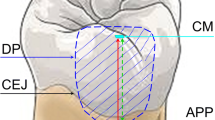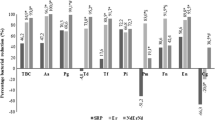Abstract
The high incidence of demineralization around orthodontic brackets has led to the development of preventive measures. Incorporation of antibacterial or remineralizing agents into orthodontic adhesives is an attractive method. This single-center, split-mouth, randomized controlled clinical trial was conducted to assess the effect of a modified composite containing TiO2 nanoparticles on the Streptococcus mutans population and to prevent demineralization around orthodontic brackets. Each participant was assigned a random sequence (AB or BA). During the bonding session, the control lateral incisor was bonded with a conventional composite and the contralateral incisor was bonded with a composite containing nano TiO2 particles (1%weight). The eligibility criteria included the presence of S. mutans in the dental plaque and absence of active caries, fractures or cracks. The S. mutans count in the dental plaque immediately around the brackets was evaluated at baseline and 1, 3, and 6 months after bonding. The specificity of the colonies was determined by PCR. The DIAGNOdent score was assessed at baseline and re-assessed every month up to the sixth month. Salivary samples were collected at T0, T1, and T3 to assess the amount of Ti released from the composite. The cytotoxicity of the modified composites was evaluated using an MTT assay. Participants, examiners, and data analyzers were blinded to the test and intervention groups. Forty-two patients ranging from 12 to 25 years were enrolled in this study. The amount of Ti released into saliva was insignificant and far below the toxic level. There was no significant difference between the S. mutans counts of the studied tooth S. mutans counts at any time point evaluated. DIAGNOdent scores on both sides increased significantly after the first month. However, this increase was higher on the test side (p < 0.001), and a significant difference of 2.6 scores remained throughout the study period. No severe adverse events were observed. Orthodontic composites containing TiO2 nanoparticles may prevent demineralization induced around brackets during orthodontic treatment. However, the antibacterial effects were not statistically significant.
Registration: The protocol was registered with the IRCT.ir (IRCT20140215016582N6).







Similar content being viewed by others
Data availability
Data supporting the findings of this study are available upon reasonable request from the authors.
References
Soltani MK, Jafari F, Taheri M, Soltanian AR, Khoshhal M, Torkaman S (2019) Effect of 5 oral hygiene teaching methods on orthodontic patients: a single-blind randomized controlled clinical trial. Hamadan Univ Med Sci 11(2):41–47. https://doi.org/10.34172/ajdr.2019.08
Sundararaj D, Venkatachalapathy S, Tandon A, Pereira A (2015) Critical evaluation of incidence and prevalence of white spot lesions during fixed orthodontic appliance treatment: a meta-analysis. J Int Soc Prev Community Dent 5(6):433. https://doi.org/10.4103/2231-0762.167719
Tasios T, Papageorgiou SN, Papadopoulos MA, Tsapas A, Haidich AB (2019) Prevention of orthodontic enamel demineralization: a systematic review with meta-analyses. Orthod Craniofac Res 22(4):225–235. https://doi.org/10.1111/OCR.12322
Kamber R, Meyer-Lueckel H, Kloukos D, Tennert C, Wierichs RJ (2021) Efficacy of sealants and bonding materials during fixed orthodontic treatment to prevent enamel demineralization: a systematic review and meta-analysis. Sci Rep 11(1):1–10. https://doi.org/10.1038/s41598-021-95888-6
Sardana D, Zhang J, Ekambaram M, Yang Y, McGrath CP, Yiu CKY (2018) Effectiveness of professional fluorides against enamel white spot lesions during fixed orthodontic treatment: a systematic review and meta-analysis. J Dent 2019(82):1–10. https://doi.org/10.1016/j.jdent.2018.12.006
Bencze MA, Albu CC, Teodorescu E et al (2022) Clinical use of nanoparticles in orthodontics as possible aid to reduce the incidence of white spot lesions. Mater Plast 59(1):156–176. https://doi.org/10.37358/MP.22.1.5569
Sodagar A, Akhoundi MSA, Bahador A et al (2017) Effect of TiO2 nanoparticles incorporation on antibacterial properties and shear bond strength of dental composite used in orthodontics. Dental Press J Orthod 22(5):67–74. https://doi.org/10.1590/2177-6709.22.5.067-074.oar
Kotta M, Gorantla S, Muddada V et al (2020) Antibacterial activity and debonding force of different lingual retainers bonded with conventional composite and nanoparticle containing composite: an in vitro study. J World Fed Orthod 9(2):80–85. https://doi.org/10.1016/j.ejwf.2020.03.001
Ahrari F, Eslami N, Rajabi O, Ghazvini K, Barati S (2015) The antimicrobial sensitivity of Streptococcus mutans and Streptococcus sangius to colloidal solutions of different nanoparticles applied as mouthwashes. Dent Res J (Isfahan) 12(1):44–49. https://doi.org/10.4103/1735-3327.150330
Mollabashi V, Farmany A, Alikhani MY et al (2020) Effects of TiO2-coated stainless steel orthodontic wires on streptococcus mutans bacteria: a clinical study. Int J Nanomedicine 15:8759–8766. https://doi.org/10.2147/IJN.S258440
Monica A, Padmanabhan S (2022) The effect of nitrogen-doped titanium dioxide-modified stainless steel brackets on Streptococcus mutans: a randomized clinical trial. Angle Orthod 93(2):396–401. https://doi.org/10.2319/062521-510.1
Sardana D, Li KY, Ekambaram M, Yang Y, McGrath CP, Yiu CK (2022) Validation of clinical photography and a laser fluorescence device for assessment of enamel demineralization during multi-bracketed fixed orthodontic treatment. Photodiagnosis Photodyn Ther 38:102828. https://doi.org/10.1016/J.PDPDT.2022.102828
Yassaei S, Nasr A, Zandi H, Motallaei MN (2020) Comparison of antibacterial effects of orthodontic composites containing different nanoparticles on streptococcus mutans at different times. Dental Press J Orthod 25(2):52–60. https://doi.org/10.1590/2177-6709.25.2.052-060.oar
Heravi F, Ramezani M, Poosti M, Hosseini M, Shajiei A, Ahrari F (2013) In vitro cytotoxicity assessment of an orthodontic composite containing titanium-dioxide nano-particles. J dent res, dent clin, dent prospects 7(4):192. https://doi.org/10.5681/joddd.2013.031
Pellegrini P, Sauerwein R, Finlayson T et al (2009) Plaque retention by self-ligating vs elastomeric orthodontic brackets: quantitative comparison of oral bacteria and detection with adenosine triphosphate-driven bioluminescence. Am J Orthod Dentofac Orthop 135(4):426.e1-426.e9. https://doi.org/10.1016/j.ajodo.2008.08.018
Franco e Franco TCC, Amoroso P, Marin JM, de Ávila FA (2007) Detection of Streptococcus mutans and Streptococcus sobrinus in dental plaque samples from Brazilian preschool children by polymerase chain reaction. Braz Dent J 18(4):329–333. https://doi.org/10.1590/S0103-64402007000400011
Jahanbin A, Farzanegan F, Atai M, Jamehdar SA, Golfakhrabadi P, Shafaee H (2017) A comparative assessment of enamel mineral content and Streptococcus mutans population between conventional composites and composites containing nano amorphous calcium phosphate in fixed orthodontic patients: a split-mouth randomized clinical trial. Eur J Orthod 39(1):43–51. https://doi.org/10.1093/ejo/cjw009
Kamber R, Meyer-Lueckel H, Kloukos D, Tennert C, Wierichs RJ (2021) Efficacy of sealants and bonding materials during fixed orthodontic treatment to prevent enamel demineralization: a systematic review and meta-analysis. Sci Rep 11(1):1–10. https://doi.org/10.1038/s41598-021-95888-6
Restrepo M, Bussaneli DG, Jeremias F et al (2016) Control of white spot lesions with use of fluoride varnish or chlorhexidine gel during orthodontic treatment a randomized clinical trial. J Clin Pediatr Dent 40(4):274–280. https://doi.org/10.17796/1053-4628-40.4.274
Dong H, Zeng G, Tang L et al (2015) An overview on limitations of TiO2-based particles for photocatalytic degradation of organic pollutants and the corresponding countermeasures. Water Res 79:128–146. https://doi.org/10.1016/j.watres.2015.04.038
Jovanović B (2015) Critical review of public health regulations of titanium dioxide, a human food additive. Integr Environ Assess Manag 11(1):10–20. https://doi.org/10.1002/ieam.1571
Bischoff NS, de Kok TM, Sijm DTHM et al (2021) Review possible adverse effects of food additive e171 (Titanium dioxide) related to particle specific human toxicity, including the immune system. Int J Mol Sci 22(1):1–35. https://doi.org/10.3390/ijms22010207
Poosti M, Ramazanzadeh B, Zebarjad M, Javadzadeh P, Naderinasab M, Shakeri MT (2013) Shear bond strength and antibacterial effects of orthodontic composite containing TiO2 nanoparticles. Eur J Orthod 35(5):676–679. https://doi.org/10.1093/ejo/cjs073
Venkatesan K, Kailasam V, Padmanabhan S (2020) Evaluation of titanium dioxide coating on surface roughness of nickel-titanium archwires and its influence on Streptococcus mutans adhesion and enamel mineralization: a prospective clinical study. Am J Orthod Dentofac Orthop 158(2):199–208. https://doi.org/10.1016/j.ajodo.2019.07.019
Oscarson P, Lif Holgerson P, Sjöström I, Twetman S, Stecksén-Blicks C (2006) Influence of a low xylitol-dose on mutans streptococci colonisation and caries development in preschool children. Eur Arch Paediatr Dent 7(3):142–147. https://doi.org/10.1007/BF03262555
Jose JE, Padmanabhan S, Chitharanjan AB (2013) Systemic consumption of probiotic curd and use of probiotic toothpaste to reduce Streptococcus mutans in plaque around orthodontic brackets. Am J Orthod Dentofac Orthop 144(1):67–72. https://doi.org/10.1016/j.ajodo.2013.02.023
Farzanegan F, Shahabi M, Niazi AE, Soleimanpour S, Shafaee H, Rangrazi A (2021) Effect of the addition of chitosan and TiO2 nanoparticles on antibacterial properties of an orthodontic composite in fixed orthodontic treatment: a randomized clinical trial study. Biomedical Physics & Engineering Express 7(4):045017. https://doi.org/10.1088/2057-1976/ac0609
Zarif Najafi H, Shavakhi M, Pakshir HR (2022) Evaluation of the preventive effect of two concentrations of xylitol varnish versus fluoride varnish on enamel demineralization around orthodontic brackets: a randomized controlled trial. Eur J Orthod 44(3):243–251. https://doi.org/10.1093/ejo/cjab049
Onwubu SC, Mdluli PS, Singh S, Nyembe S, Thakur R (2019) Corrigendum to “an in situ evaluation of the protective effect of nano eggshell/titanium dioxide against erosive acids”. Int J Dent. https://doi.org/10.1155/2018/4216415
Muhriz M, Niazy M, Elsharkawy D (2020) Remineralizing effect of nanofilled glass ionomer combined with titanium dioxide nanoparticle and nanohydroxyapatite in root caries-like lesions. Al-Azhar Dent J Girls 7(2):179–187. https://doi.org/10.21608/adjg.2020.10808.1133
Okada M, Kawamura M, Oda Y, Yasuda R, Kojima T, Kurihara H (2012) Caries prevalence associated with Streptococcus mutans and Streptococcus sobrinus in Japanese schoolchildren. Int J Paediatr Dent 22(5):342–348. https://doi.org/10.1111/J.1365-263X.2011.01203.X
Acknowledgements
The authors would like to acknowledge the postgraduate orthodontics students Mahsa Asadimanesh, Anahita Morrovat, and Behrooz Khodabandehloo for their kind assistance during the study course.
Funding
This study was supported by the Vice Chancellor of Research and Technology at the Hamadan University of Medical Sciences, Hamadan, Iran. (Grant No: 140010218555).
Author information
Authors and Affiliations
Contributions
V. M. conceptualization, methodology, writing (review and editing), M.So: resources, data curation, writing, MR.A. methodology, writing, M.F. validation, formal analysis, writing, and editing, R.A. resources, data curation, software, writing and M.Sa. conceptualization, resources, data curation, writing. All authors reviewed the manuscript.
Corresponding author
Ethics declarations
Competing interests
The authors declare no competing interests.
Ethics approval and consent to participate
The study was approved by the Ethics Committee of the Hamadan University of Medical Sciences. (IR.UMSHA. REC.1400.445).
Conflict of interest
The authors declare no competing interests.
Additional information
Publisher's Note
Springer Nature remains neutral with regard to jurisdictional claims in published maps and institutional affiliations.
Rights and permissions
Springer Nature or its licensor (e.g. a society or other partner) holds exclusive rights to this article under a publishing agreement with the author(s) or other rightsholder(s); author self-archiving of the accepted manuscript version of this article is solely governed by the terms of such publishing agreement and applicable law.
About this article
Cite this article
Mollabashi, V., Soleymani, M., Arabestani, M.R. et al. Evaluation of Nano TiO2 Modified Orthodontic Composite Effects on S. mutans Population and Enamel Demineralization in Fixed Orthodontic Patients; a Split Mouth Randomized Controlled Clinical Trial. Biol Trace Elem Res 201, 4657–4666 (2023). https://doi.org/10.1007/s12011-023-03559-6
Received:
Accepted:
Published:
Issue Date:
DOI: https://doi.org/10.1007/s12011-023-03559-6




